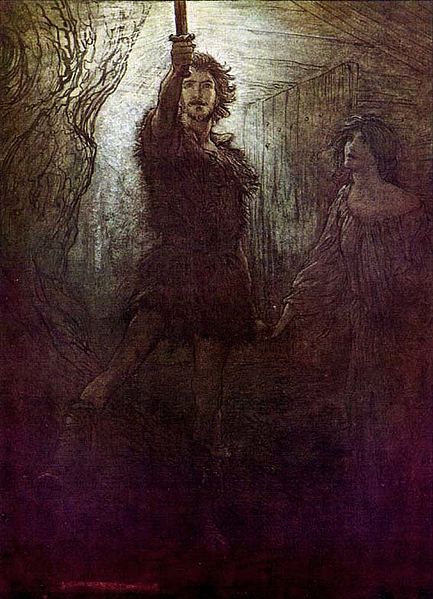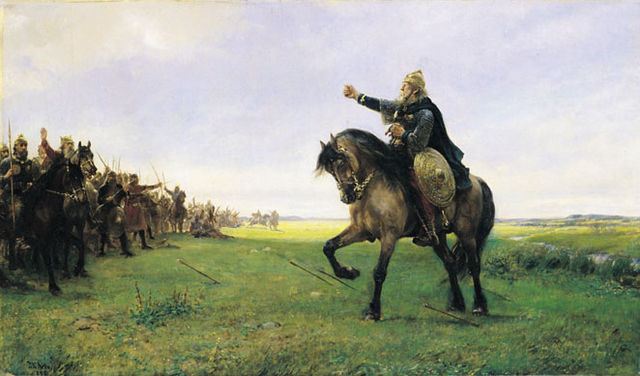Sigurd or Siegfried is a legendary hero of Germanic heroic legend, who killed a dragon—known in some Old Norse sources as Fáfnir—and who was later murdered. In both the Norse and continental Germanic tradition, Sigurd is portrayed as dying as the result of a quarrel between his wife (Gudrun/Kriemhild) and another woman, Brunhild, whom he has tricked into marrying the Burgundian king Gunnar/Gunther. His slaying of a dragon and possession of the hoard of the Nibelungen is also common to both traditions. In other respects, however, the two traditions appear to diverge. The most important works to feature Sigurd are the Nibelungenlied, the Völsunga saga, and the Poetic Edda. He also appears in numerous other works from both Germany and Scandinavia, including a series of medieval and early modern Scandinavian ballads.
The death of Siegfried. Hagen stands to the right of Siegfried with a bow. From the Hundeshagenscher Kodex.
"Sigurd proofs the sword Gram" (1901) by Johannes Gehrts.
Siegfried's Departure from Kriemhild, by Julius Schnorr von Carolsfeld, c. 1843
Relief "Siegfried in Xanten" on the Nordwall in Xanten.
Germanic heroic legend is the heroic literary tradition of the Germanic-speaking peoples, most of which originates or is set in the Migration Period. Stories from this time period, to which others were added later, were transmitted orally, traveled widely among the Germanic speaking peoples, and were known in many variants. These legends typically reworked historical events or personages in the manner of oral poetry, forming a heroic age. Heroes in these legends often display a heroic ethos emphasizing honor, glory, and loyalty above other concerns. Like Germanic mythology, heroic legend is a genre of Germanic folklore.
Hagen kills Siegfried while the Burgundian kings Gunther, Giselher, and Gernot watch. Julius Schnorr von Carolsfeld, 1847.
A depiction of Sigmund by Arthur Rackham.
"Neither the Huns nor their hornbows make us afraid!" The Geatish king Gizur challenges the invading Huns to a pitched battle on behalf of the Goths, from the Scandinavian epic poem Battle of the Goths and the Huns, which preserves place names from the Gothic rule in South-Eastern Europe. Painting by Peter Nicolai Arbo, 1886.
The shieldmaiden Hervor dying after the Battle of the Goths and Huns, by Peter Nicolai Arbo, before 1892.








